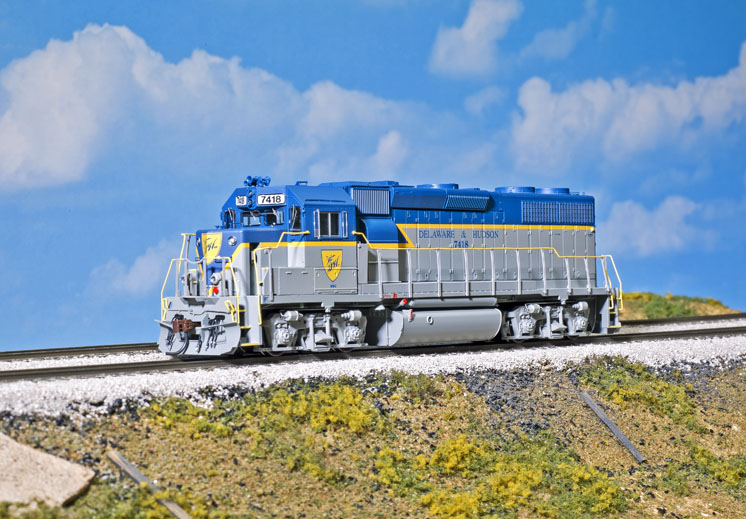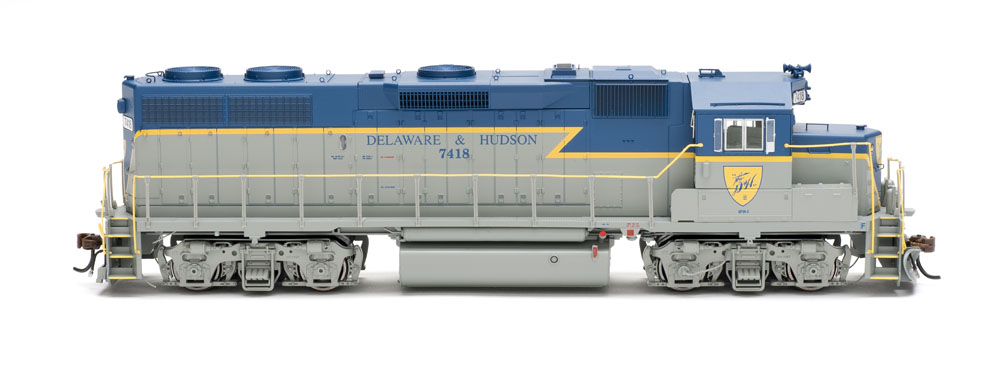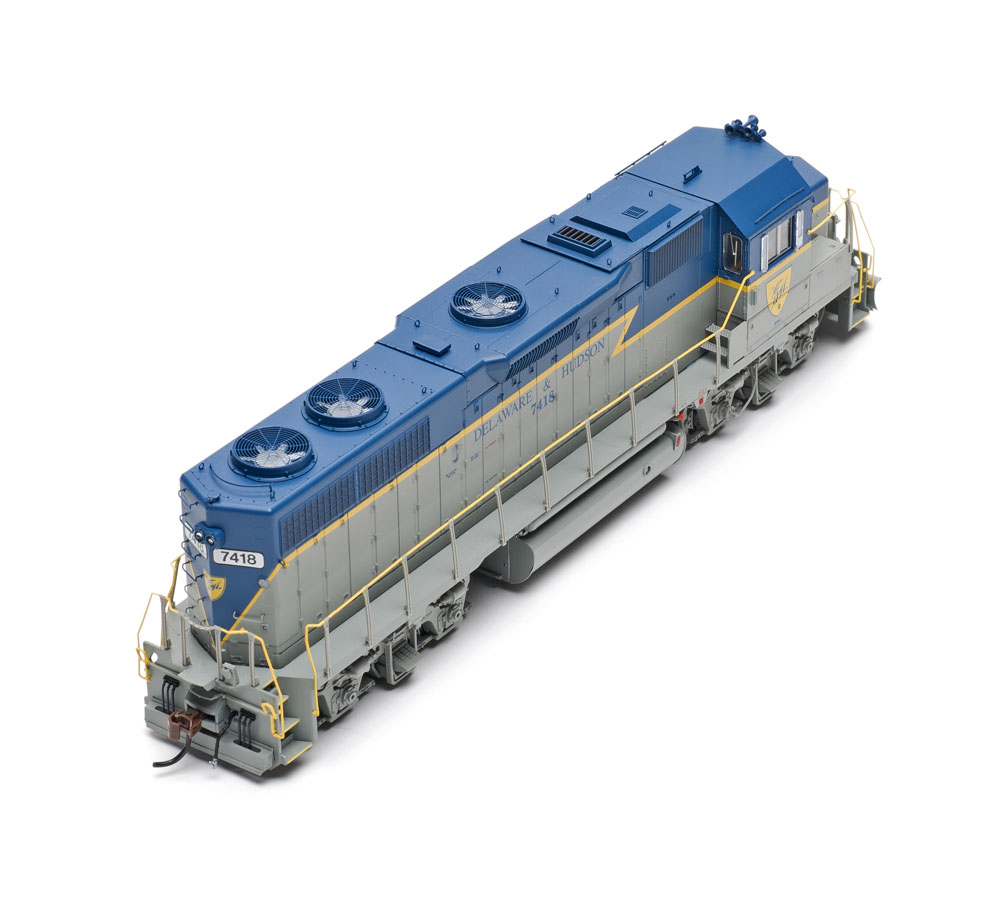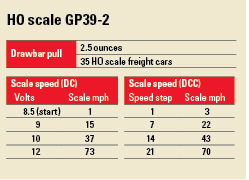A General Motors Electro-Motive Division GP39-2 joins the Athearn Genesis series, and it doesn’t disappoint. The Genesis series is known for meticulously detailed, roadname- and roadnumber- specific HO scale models. The factory-equipped SoundTraxx Tsunami decoder in our review sample added super sounds to the superdetailed locomotive.
The prototype. Electro-Motive built 239 GP39-2 diesel locomotives for North American customers from 1974 to 1984. Part of EMD’s upgraded Dash 2 series, the GP39-2 also featured a turbocharged 2,300 hp 645 diesel engine.
At 106 units, the Atchison, Topeka & Santa Fe Ry.’s GP39-2 fleet was the largest. Other Class 1 railroad customers included Burlington Northern, Delaware & Hudson, and Reading Co.
After the Reading was absorbed into Conrail in 1976, the United States government transferred ownership of all 20 Reading GP39-2s to the D&H. Numbered 7401 to 7420, these ex-Reading Geeps complemented D&H’s existing GP39-2 fleet (nos. 7601 to 7620). Most of the 7401 series wore a patched-out Reading livery into the 1980s.
After Guilford Transportation purchased the D&H in 1984, the Geeps received that company’s orange-and-dark-gray scheme. Then Guilford declared the D&H bankrupt in 1988. Back under employee ownership, no. 7418 finally got repainted in the classic D&H lightning-stripe scheme. The railroad was then sold to CP Rail in 1991, and CP sold the GP39-2s to CSX. According to prototype photos, no. 7418 remained in D&H lightning stripes while working CSX rails into the 1990s.
Accurate details. Like other diesels, the GP39-2 received external upgrades during its production run. Railfans use these spotting features to differentiate the locomotives into “phases.”
The dimensions of the HO locomotive match a prototype drawing of a GP39-2 printed in the December 1988 issue of Mainline Modeler. Correct for its D&H (ex-RDG) prototype, our review sample is detailed for a phase I GP39-2. The short hood length is 81″ (vs. 88″ on a phase II GP39-2) and all the long hood details are correctly positioned to represent the engine location on early production units. On a phase II GP39-2, the diesel engine was located 3 feet rearward, which shifted details such as the blower duct farther back and moved the radiator fans closer together.
Athearn also did a great job superdetailing the model to be roadnumber- and era-specific. The model features many separately applied detail parts, including the Nathan K5LA23 air horn, Sinclair “ice skate” antenna, rectangular cab vent, and cab mirrors and wind deflectors. The model correctly lacks sunshades and has a 2,900 gallon fuel tank.
Other separate detail parts include formed wire grab irons and lift rings. The handrails and stanchions are made of flexible plastic. The parts are scale thickness but the stanchions have a tendency to bow inward and easily pop loose from the holes along the side sills. A pinpoint drop of cyanoacrylate adhesive would help secure the stanchions.
Although many locomotives in EMD’s Dash 2 product line rode on Blomberg type M trucks, our review sample correctly models its prototype with earlier Blomberg type B trucks. These trucks are easily identifiable by the leaf spring in the center of the sideframe instead of the rubber pads found in the later type M trucks.
The model’s paint scheme features sharp color separation. The emblem placement and font correctly represents no. 7418 after its 1989 repaint into D&H lightning stripes.
Performance. Removing the couplers allowed me to lift off the body shell. The can motor and flywheels are mounted in the center of the die-cast metal frame. All-wheel drive is provided by universal shafts and truck-mounted gearboxes.
Like other Athearn locomotives, lighting is provided by incandescent bulbs. The bulbs look realistic, but may require replacement sooner than comparable light-emitting diodes (LEDs). The SoundTraxx Tsunami decoder is mounted above the motor. A downward-facing speaker is mounted above the rear truck.
The heavy frame and all-wheel drive provide the GP39-2 with a respectable 2.5 ounce drawbar pull, enough to pull a 35-car cut. The mechanism also kept the locomotive rolling smoothly to prototypical top speeds during our speed tests, shown in the charts at right.
Like other dual-mode decoder equipped locomotives, the GP39-2 required a lot of track power to get going during direct-current (DC) operation. Sound and lights started at 7.5V, and the locomotive didn’t start rolling until I applied 8V to the track.
During Digital Command Control (DCC) tests the locomotive performed reliably out of the box with the default setting of 28 speed steps. After I set the decoder to 128 speed steps, I had even finer slow speed control, as the model started moving at less than 1 scale mph in speed step 1. In DCC I could further fine-tune performance by adding momentum and setting up speed tables. A printed list of all the programmable configuration variables (CVs) is included with the model. A more extensive programming guide is available as a free download at the Athearn website.
Sound and lights. For comparison I placed the GP39-2 on the rails next to a SoundTraxx-equipped GP38-2. I could hear the difference between the two 645 prime movers, as the GP39-2 had the correct turbocharger whine compared to the more throaty sound of the naturally aspirated engine in the GP38-2.
In DC operation, the headlights and ditch lights are directional and the sound is limited to automatic effects. The engine rpm revs up or down with the throttle setting. Whenever I flipped the direction switch on the DC power pack, the sound cut out momentarily, which I found distracting.
The bell rang at speeds under 10 scale mph and a grade crossing signal sounded when I quickly advanced the throttle. Other automatic sound effects can be added, but to do so requires a DCC system or DC sound controller.
With a DCC system, I had much more control over the locomotive’s sound effects. Pressing function 2 sounded an accurate Nathan K5LA air-horn blast, while function 3 sounded a short toot. All the sounds have individually programmable volume levels. For example, I could program the horn at the loudest setting to make sure it’s always audible above the rumble of the diesel engine.
Other user-triggered DCC features include the bell, coupler crash, and the dynamic brake fan. I also set up the “train brake” feature. This lets me use a function button to set or release the brakes independent of the throttle setting for more realistic control.
By default function 0 activates the GP39-2’s directional headlights, which turn on or off automatically according to the locomotive’s direction of travel. Function 7 dims the headlights and function 6 turns on the ditch lights in the forward direction. For more realistic operation, I programmed the headlights to operate via independent function button control.
Smooth DCC operation, realistic sound, and spot-on detailing make this GP39-2 a worthy addition to an HO scale diesel roster.
Price: $269.98 (DCC, sound), $169.98 (DC, no sound)
Manufacturer
Athearn Trains
1600 Forbes Way, Ste. 120
Long Beach, CA 90810
www.athearn.com
Era: late 1980s to 1990s (as detailed and decorated for D&H)
Road names (multiple numbers): Delaware & Hudson; Atchison, Topeka & Santa Fe; Burlington Northern; Portland & Western; Reading Co.
Features
▪▪All-wheel drive and pickup
▪▪DCC Quick Plug accepts 8- or 9-pin decoders (DC version)
▪▪Dual-mode SoundTraxx decoder (DCC version only)
▪▪Five-pole skew-wound motor with dual brass flywheels
▪▪McHenry scale knuckle couplers at correct height
▪▪Metal RP-25 contour wheels in gauge
▪▪Weight: 13.8 ounces


















